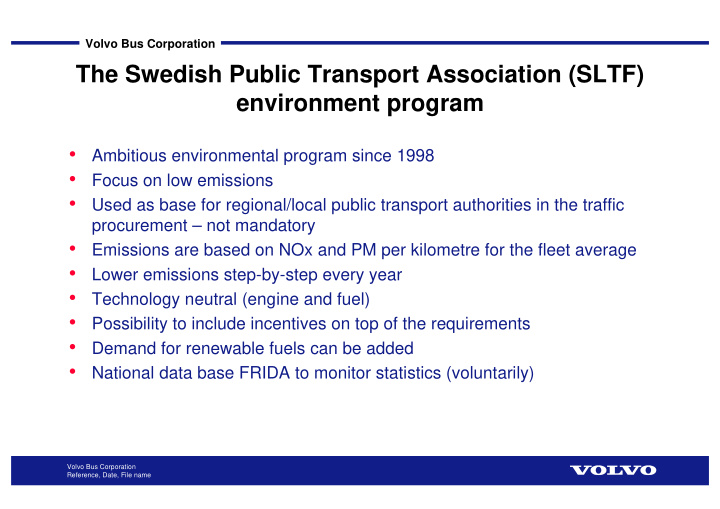



Volvo Bus Corporation The Swedish Public Transport Association (SLTF) environment program • Ambitious environmental program since 1998 • Focus on low emissions • Used as base for regional/local public transport authorities in the traffic procurement – not mandatory • Emissions are based on NOx and PM per kilometre for the fleet average • Lower emissions step-by-step every year • Technology neutral (engine and fuel) • Possibility to include incentives on top of the requirements • Demand for renewable fuels can be added • National data base FRIDA to monitor statistics (voluntarily) Volvo Bus Corporation Reference, Date, File name
Volvo Bus Corporation SLTFs emission prerequisites Base demands Extended demands (city) Year NOx PM Year NOx PM 2004 6.0 0.03 2004 5.0 0.02 2005 5.7 0.02 2005 4.5 0.02 2006 5.4 0.02 2006 4.0 0.02 2007 5.0 0.02 2007 3.5 0.02 2008 4.7 0.02 2008 3.0 0.02 2009 4.2 0.02 2009 2.5 0.02 2010 3.8 0.02 2010 2.0 0.02 2011 3.5 0.02 2011 2.0 0.02 2012 3.5 0.02 2012 2.0 0.02 2013 3.5 0.02 2013 2.0 0.02 Volvo Bus Corporation Reference, Date, File name
Volvo Bus Corporation Number of buses in Sweden with alternative fuels Total bus fleet in line haulage: ~8.000 buses (2002) Number of bus trips: 600 million (2002) Distance travelled: 500 million km (2002) Ethanol: 400 buses, 19.000 m 3 fuel consumption Compressed biogas (CBG): ~300 buses Compressed natural gas (CNG): ~350 buses Hydrogen: 3 buses (460 Volvo CNG/CBG) A total of 1.050 buses runs on alternative fuels – 13 % of the total Largest increase in CNG and CBG Volvo Bus Corporation Reference, Date, File name
Volvo Bus Corporation Number of buses in Sweden with diesel after treatment (2004) Oxidizing catalysts: ~2.000 buses Particulate traps: ~3.000 buses Particulate traps and EGR: 500 buses Particulate traps and SCR: 60 All diesel sold in Sweden are MK 1 (max. 10 ppm sulphur, 5 % total aromatics, 0.02 % heavy aromatics) Volvo Bus Corporation Reference, Date, File name
Volvo Bus Corporation Emission prerequisites in Gothenburg Values in tender with start of operation June 2004 For the island of Hisingen north of the river Year 2004 2005 2006 2007 2008 2009 2010 2011 2012 2013 NOx 5,0 4,5 4,0 3,5 3,0 2,5 2,0 2,0 2,0 2,0 Particul. 0,02 0,02 0,02 0,02 0,02 0,02 0,02 0,02 0,02 0,02 Ren. fuel % 5 5 5 5 5 5 5 5 5 5 For the eastern part of the city Year 2004 2005 2006 2007 2008 2009 2010 2011 2012 2013 NOx 4,0 3,0 2,0 2,0 2,0 2,0 2,0 2,0 2,0 2,0 Particul. 0,02 0,02 0,02 0,02 0,02 0,02 0,02 0,02 0,02 0,02 Ren.fuel % 15 20 25 30 30 30 30 30 30 30 There are also incentives if environmental values are lower than required Volvo Bus Corporation Reference, Date, File name
Volvo Bus Corporation 2004 emissions for city buses in Gothenburg • Average particulate emissions is 0.025 gram Average NOx emissions is 3,7 gram/kWh = 25 % lower than Euro 3 • /kWh = 75 % lower than Euro 3 • Average procentage renewable fuel is 25 %, mostly biogas and some RME mixed into diesel fuel Volvo Bus Corporation Reference, Date, File name
Volvo Bus Corporation Benefits with the concept • Fleet average emission per kilometre travelled • Incremental step in lower emission each year • Focus on PM emissions in city environment • Gives a flexible option to retrofit existing buses • Gives a cost efficient turnover of rolling stock • Provides a opportunity to use higher emission buses on low mileage routes • Gives a possibility to implement new technology on existing and new buses • Follow up program ensures fulfilment • Possible to get incentives for lower emissions than demanded • Neutral to the operators concerning technology and fuels • Consensus in the industry of the concept makes a broad implementation effective • Good progress have been made so far – lowest emissions in the world Volvo Bus Corporation Reference, Date, File name
Volvo Bus Corporation Examples of technologies used – added vehicle cost and PM- and NOx reduction PM (%) NOx (%) • Oxidizing catalysts € 2.000 20 - • Particulate traps € 6.000 90 - • Particulate traps with EGR € 15.000 90 50 • Particulates traps with SCR € 18.000 90 75 • CNG/CBG € 40.000 90 75 • Ethanol in diesel engines € 30.000 70 50 Volvo Bus Corporation Reference, Date, File name
Volvo Bus Corporation Legislation – not only emission levels Volvo Bus Corporation Reference, Date, File name
Recommend
More recommend